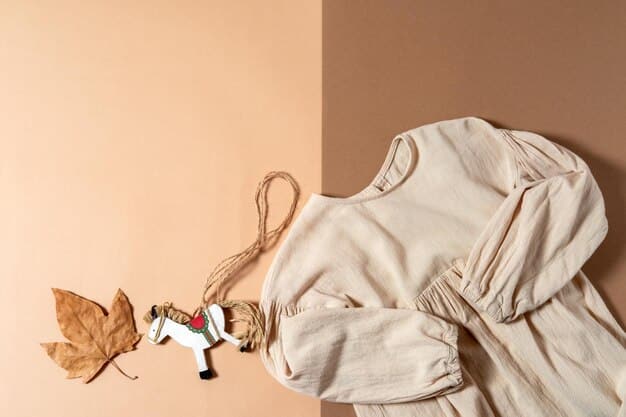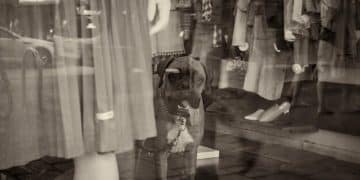The Complete Guide to Sustainable Style: Building an Eco-Friendly Wardrobe in 2025

Building a sustainable wardrobe in 2025 means embracing ethical sourcing, conscious consumption, and longevity, transforming personal style into a powerful statement for environmental and social responsibility while minimizing fashion’s ecological footprint through informed choices.
Diving into the world of fashion often brings with it a certain level of excitement and self-expression. Yet, beneath the allure of new trends and seasonal collections, there’s a growing awareness of the environmental and social impact of our clothing choices. This is where The Complete Guide to Sustainable Style: Building an Eco-Friendly Wardrobe in 2025 becomes not just relevant, but essential. It’s about more than just looking good; it’s about doing good, making choices that resonate with your values, and contributing to a healthier planet while maintaining a chic aesthetic.
Understanding the Urgency of Sustainable Fashion
The fashion industry, often celebrated for its creativity and innovation, also carries a significant environmental burden. From the extensive water usage in cotton cultivation to the chemical pollution from dyeing processes and the massive waste generated by fast fashion, its ecological footprint is undeniable. As we move further into the 21st century, the need for a fundamental shift towards more sustainable practices becomes increasingly urgent. Consumers, designers, and brands alike are recognizing that the linear “take-make-dispose” model is no longer viable.
Beyond environmental concerns, there are crucial social considerations. The supply chains of many fashion brands are complex, often involving labor practices that fall short of ethical standards. Workers, predominantly women, in developing countries may face low wages, poor working conditions, and limited rights. A truly sustainable approach encompasses both environmental stewardship and social equity, advocating for fair labor practices, safe working environments, and fair compensation across the entire production chain. This holistic view is paramount for any genuine move towards sustainability in fashion.
The Environmental Cost of Fast Fashion
Fast fashion’s business model thrives on rapid production cycles, quickly turning trends into cheap, disposable garments. This constant churn has devastating effects:
- Resource Depletion: High demand for raw materials strains natural resources, from water for irrigation to petroleum for synthetic fibers.
- Pollution: Textile dyeing and finishing are major sources of water pollution, while microplastic shedding from synthetic clothes contaminates oceans.
- Waste Overload: Millions of tons of textiles end up in landfills annually, where they can take hundreds of years to decompose, releasing greenhouse gases.
Understanding these impacts is the first step towards embracing a more sustainable wardrobe. It’s about recognizing the true cost hidden beneath the appealing price tags of fast fashion items. Informed decisions start with awareness.
Social Impact and Ethical Production
The human cost of fast fashion is equally troubling. Many garments are produced in factories where workers face:
- Unsafe Conditions: Fire hazards, structural collapses, and exposure to toxic chemicals are not uncommon.
- Low Wages: Wages are often below a living wage, trapping workers in cycles of poverty.
- Long Hours: Excessive working hours, often without overtime pay, are regularly reported.
Opting for brands that prioritize transparency and ethical labor practices ensures that your fashion choices contribute to a more just and equitable industry. Certifications and third-party audits can offer some assurance, though direct communication with brands about their supply chains is always valuable. Supporting brands committed to fair trade principles is a practical way to effect change.
The urgency of sustainable fashion extends beyond individual closets; it’s a global imperative that demands systemic change. By aligning our purchasing power with brands that uphold ethical and environmental standards, we contribute to a collective movement towards a fashion industry that respects both people and the planet. This fundamental shift requires not just awareness, but concerted action from all stakeholders.
Key Principles of an Eco-Friendly Wardrobe in 2025
Building an eco-friendly wardrobe isn’t just about buying “sustainable” clothing; it’s about adopting a mindful approach to your entire consumption cycle. In 2025, this involves several core principles that guide purchasing decisions, garment care, and end-of-life management. It moves beyond simple material choices to embrace a philosophy of longevity, versatility, and responsible engagement with the fashion ecosystem. Adopting these principles allows for a deeply personal and effective sustainability journey.

Embrace Durability and Longevity
One of the most impactful ways to reduce your wardrobe’s footprint is to invest in high-quality, durable pieces that are built to last. Fast fashion’s rapid cycles encourage disposability, but an eco-friendly wardrobe prioritizes longevity. Look for:
- Quality Construction: Strong seams, durable zippers, and well-finished details indicate a garment designed for wear. Inspect stitching and fabric integrity.
- Timeless Design: Opt for classic silhouettes and versatile colors that won’t quickly go out of style. These pieces form the backbone of a sustainable wardrobe.
- Versatile Pieces: Choose items that can be mixed and matched to create multiple outfits for various occasions, maximizing their utility.
A durable garment, even if initially more expensive, offers a lower cost-per-wear over its lifespan and significantly reduces waste. This shift in mindset from quantity to quality is foundational.
Prioritize Natural and Recycled Materials
The fibers our clothes are made from have a profound environmental impact. In 2025, conscious consumers are increasingly seeking alternatives to conventional materials:
- Organic Cotton: Grown without harmful pesticides or synthetic fertilizers, it’s better for soil health and water quality. Ensure it’s certified organic.
- Linen and Hemp: These natural fibers require less water and fewer pesticides, and are incredibly durable. They offer breathability and comfort.
- Recycled Polyester (rPET): Made from plastic bottles, it diverts waste from landfills and reduces reliance on virgin fossil fuels.
- TENCEL™ Lyocell/Modal: Derived from sustainably sourced wood pulp using a closed-loop process, making it very water-efficient.
Understanding the properties and production methods of different materials empowers better choices. Researching fabric origins and certifications, such as GOTS (Global Organic Textile Standard) for organic cotton or OEKO-TEX for chemical safety, provides added assurance.
Support Ethical and Transparent Brands
Beyond materials, the practices of the brands themselves are crucial. An eco-friendly wardrobe involves supporting companies committed to ethical labor, fair wages, and transparency in their supply chains. Key considerations include:
- Certifications: Look for certifications like Fair Trade, B Corp, or SA8000, which indicate adherence to social and environmental standards.
- Supply Chain Transparency: Brands that openly share information about their factories, material suppliers, and labor practices demonstrate accountability.
- Commitment to Circularity: Brands that offer repair services, take-back programs, or design for recyclability contribute to a more circular economy.
Online resources and directories dedicated to sustainable fashion brands can help in this discovery process. Engaging with brands on social media or direct communication can also provide insight into their values and practices. Every purchase sends a message, and supporting ethical brands strengthens the movement towards a more responsible industry.
Building Your Eco-Friendly Foundation: Capsule Wardrobes and Versatility
A pivotal strategy for an eco-friendly wardrobe is the concept of a capsule wardrobe. Instead of accumulating numerous items, a capsule wardrobe focuses on a limited number of versatile pieces that can be mixed and matched to create a wide array of outfits. This approach minimizes textile waste, reduces the need for frequent purchases, and encourages creativity with what you already own. It’s about maximizing utility and minimizing redundancy, leading to a more intentional and sustainable personal style. This strategy has proven highly effective for many.
The Power of the Capsule Wardrobe
Creating a capsule wardrobe involves a thoughtful curation process. It typically consists of 25-50 items (excluding underwear, sleepwear, and activewear) chosen for their timeless appeal, durability, and ability to be combined in various ways. The benefits are manifold:
- Reduced Consumption: Fewer new purchases mean less environmental impact from production.
- Financial Savings: Investing in fewer, higher-quality pieces often saves money in the long run.
- Simplified Dressing: A cohesive wardrobe makes choosing outfits quicker and less stressful.
- Personal Style Clarity: It helps identify what truly suits your personal aesthetic and lifestyle.
To start, assess your current wardrobe, identifying pieces you love, wear frequently, and that fit well. Remove items that don’t serve a purpose or bring you joy. This decluttering phase is crucial for an effective capsule. Then, identify core pieces that form the foundation, such as neutral-colored bottoms, complementary tops, and versatile outerwear.
Focus on Versatility and Multi-Wear
When selecting pieces for your sustainable wardrobe, prioritize items that can adapt to different occasions and seasons. A versatile garment is one that can be dressed up or down, layered, or worn in multiple ways. This approach means you need fewer items to meet all your style needs, reinforcing the “less is more” philosophy crucial for eco-conscious fashion. Think about the functionality of each new addition.
For example, a classic black dress can transition from a professional setting to an evening event with different accessories. A well-fitting pair of jeans can be casual during the day and elevated for an evening out. Consider items that can be layered for warmth or styled for cooler temperatures, extending their seasonal utility. Multi-functional pieces reduce the necessity for highly specialized clothing, which often gets worn infrequently. This conscious selection process reduces overall consumption and waste.
Accessorizing Smartly
Accessories play a vital role in an eco-friendly capsule wardrobe. They offer an opportunity to infuse personality and refresh outfits without purchasing new garments. Focus on:
- Scarves: Can be worn around the neck, as headbands, tied to bags, or even as makeshift tops.
- Jewelry: Invest in timeless, durable pieces made from recycled metals or ethically sourced materials.
- Bags and Shoes: Choose versatile styles that complement multiple outfits and are built to last.
Thoughtful accessorizing allows for endless outfit combinations from a limited clothing base, maximizing your wardrobe’s potential. It’s an effective way to embrace creativity within sustainable limits. By building an eco-friendly foundation based on capsule principles and versatility, you create a wardrobe that is not only stylish but also deeply aligned with sustainable living practices.
Sustainable Sourcing Strategies for 2025
Acquiring clothing for an eco-friendly wardrobe goes beyond traditional retail. In 2025, sustainable sourcing involves exploring diverse avenues that reduce environmental impact and promote ethical consumption. This means looking beyond new production and embracing existing resources. It’s about extending the life cycle of garments and supporting business models that prioritize circularity over linearity. Developing diverse sourcing strategies is critical for a truly sustainable approach.
Embracing Secondhand and Vintage
One of the most impactful ways to build a sustainable wardrobe is by shopping secondhand or vintage. This directly reduces textile waste and the demand for new production, which consumes vast resources. The options are wider than ever:
- Thrift Stores: Local thrift stores offer affordable, unique finds and support community initiatives.
- Consignment Shops: Often feature higher-quality, curated selections of pre-owned designer or brand-name clothing.
- Online Marketplaces: Platforms like ThredUp, Poshmark, Depop, and eBay connect buyers and sellers of used clothing globally.
- Vintage Stores: Specializing in older, often unique pieces that add character and history to your wardrobe.
Washing and mending secondhand items can give them a new life, turning them into cherished additions to your collection. This practice not only benefits the planet but also offers an opportunity for unique style expression. Discovering a one-of-a-kind vintage piece can be far more rewarding than buying a mass-produced item.
Considering Clothing Rentals and Swaps
For special occasions or to experiment with new styles without a long-term commitment, clothing rental services are an excellent sustainable option. Platforms like Rent the Runway allow temporary access to high-end fashion, reducing the need to buy specific outfits that might only be worn once. This model promotes shared resource use and minimizes individual ownership of rarely-used items. It’s a pragmatic solution for event-specific attire.
Clothing swaps with friends or community groups also offer a fantastic way to refresh your wardrobe sustainably. Participants bring unwanted garments and exchange them for “new-to-you” items, fostering a sense of community while diverting clothes from landfills. These events provide a fun, social, and zero-cost way to update your style. Both rental and swap models embody a collaborative approach to fashion consumption.
Supporting Emerging Sustainable Brands
As the sustainable fashion movement grows, more brands are emerging with strong commitments to ethical production, eco-friendly materials, and circular practices. When purchasing new items, prioritize these businesses:
- Research thoroughly: Look beyond surface-level claims. Investigate their supply chain, certifications, and public commitments to sustainability.
- Check their mission: Brands truly dedicated to sustainability often have transparent mission statements and publicly available impact reports.
- Small batch production: Many sustainable brands produce in smaller batches, reducing waste and overproduction.
These brands often invest more in quality materials and fair labor, which might mean a higher price point. However, viewing these purchases as investments in durability and ethical production aligns with the long-term benefits of an eco-friendly wardrobe. Supporting innovative businesses helps drive the entire industry toward more responsible practices. By combining secondhand, rental, and informed new purchases, you create a truly sustainable sourcing strategy.
Care and Maintenance for Longevity
Building an eco-friendly wardrobe isn’t just about how you acquire clothes; it’s equally about how you care for them. Proper care and maintenance significantly extend the lifespan of your garments, reducing the frequency of replacement and minimizing the environmental impact associated with new production. In 2025, conscious consumers recognize that garment care is an integral part of sustainable living. It’s a proactive step that protects your investment and the planet, ensuring your beloved pieces last longer.
Understanding Fabric Care Labels
Each garment comes with a care label that provides specific instructions on washing, drying, ironing, and dry cleaning. Adhering to these guidelines is crucial for preserving fabric integrity and color. Ignoring them can lead to shrinking, stretching, fading, or damage, prematurely shortening a garment’s life. Take the time to decipher these symbols, as they are your garment’s roadmap to longevity.
- Washing Symbols: Indicate water temperature, cycle type (gentle, permanent press, normal), and whether hand washing is required.
- Drying Symbols: Specify tumble dry settings (low, medium, high heat) or if line drying is recommended.
- Ironing Symbols: Suggest appropriate iron temperatures to avoid scorching or damaging fabrics.
- Dry Cleaning Symbols: Inform whether professional dry cleaning is suitable and indicate solvent types.
Knowing what these symbols mean allows for precise care, minimizing wear and tear. A quick search online can provide a comprehensive guide to interpreting these universal symbols, making garment care less of a mystery and more of a science.
Eco-Friendly Washing Practices
The way we wash our clothes has a considerable environmental impact, primarily due to water and energy consumption, as well as detergent use. Adopting eco-friendly washing habits can significantly reduce your footprint:
- Wash Less Frequently: Many items, especially outerwear or those worn for short periods, don’t need washing after every wear. Spot clean minor stains.
- Use Cold Water: Heating water for laundry consumes a large amount of energy. Cold water washing is effective for most garments and saves energy.
- Full Loads: Run your washing machine only when you have a full load, conserving water and energy. Partial loads are inefficient.
- Eco-Friendly Detergents: Choose biodegradable, plant-based detergents free from harsh chemicals, phosphates, and synthetic fragrances.
- Consider a Guppyfriend Bag: For synthetic items, use a microplastic-catching wash bag to prevent microfiber shedding into waterways.
Line drying whenever possible also saves a significant amount of energy compared to using a tumble dryer. These seemingly small changes accumulate into a major positive impact over time, contributing to a truly sustainable lifestyle. Prioritizing these practices preserves both your clothes and the environment.
Mending, Repairing, and Upcycling
When garments show signs of wear or damage, don’t discard them immediately. Mending and repairing are fundamental pillars of a sustainable wardrobe. Simple repairs like sewing on a loose button, patching a small tear, or fixing a seam can extend a garment’s life for years. Learning basic sewing skills is an empowering step towards self-sufficiency and sustainability. Many online tutorials can guide you through common repairs, making it accessible even for beginners.
For more extensive damage or to give an old item a completely new look, consider upcycling. This involves transforming old clothing into something new and functional, like turning old jeans into shorts or a skirt, or patching an old t-shirt into a cleaning rag. Upcycling not only prevents textile waste but also fosters creativity and personal expression. It challenges the notion that clothes have a single, fixed lifespan. By actively engaging in care, repair, and upcycling, you actively participate in the circular fashion movement, maximizing value and minimizing waste.

The Future of Sustainable Style: Innovations and Trends in 2025
Sustainable style is a dynamic field, constantly evolving with new technologies, consumer behaviors, and industry commitments. In 2025, we are witnessing significant innovations and trends that promise to further revolutionize how we produce, consume, and interact with fashion. These advancements are driven by a collective desire for a more responsible future, pushing the boundaries of what is possible within the industry. From revolutionary materials to data-driven transparency, the landscape is shifting rapidly. Staying informed about these developments is key to truly embracing eco-friendly practices.
Bio-Based and Regenerative Materials
The quest for truly sustainable materials is accelerating, with significant breakthroughs in bio-based and regenerative fibers. These materials aim to reduce reliance on resource-intensive conventional fabrics and petroleum-based synthetics. Key areas of development include:
- Mushroom Leather (Mycelium): An innovative, animal-free leather alternative grown from fungi, offering a durable and biodegradable option.
- Algae and Plant-Based Dyes: Natural dyes sourced from plants and algae reduce the chemical pollution associated with synthetic dyes.
- Compostable Textiles: Fabrics designed to safely biodegrade at the end of their life, returning nutrients to the soil.
- Regenerative Agriculture Cotton: Methods that improve soil health, increase biodiversity, and sequester carbon, moving beyond simply “organic.”
These materials represent a significant leap forward, offering alternatives that are both environmentally friendly and high-performing. As research continues, the integration of such materials into mainstream fashion is expected to expand, providing consumers with more sustainable choices. This frontier is particularly exciting for circular fashion systems.
Circular Fashion Systems and Technology
The concept of a circular economy, where resources are kept in use for as long as possible, is gaining traction in fashion. Technology plays a crucial role in enabling these systems. In 2025, expect to see:
- Blockchain for Transparency: Used to track garments from raw material to retail, providing immutable records of their origin, production, and ethical compliance.
- Digital Product Passports: QR codes or NFC tags on garments containing detailed information about their materials, care instructions, and end-of-life recycling options.
- AI-Powered Design and Production: Artificial intelligence is being used to optimize material usage, reduce waste in cutting, and predict demand to prevent overproduction.
- Advanced Textile Recycling: New chemical and mechanical recycling technologies that can separate mixed fibers and transform old garments into new high-quality textiles, closing the loop.
These technological advancements are making it easier for consumers to make informed choices and for brands to implement more sustainable practices. The shift allows for a more accountable and resource-efficient fashion industry, moving away from wasteful linear models toward truly circularity. Embracing these innovations is paramount.
Consumer Awareness and Policy Shifts
Beyond technological innovations, increased consumer awareness and governmental policies are driving forces for sustainable fashion. Consumers are demanding more transparency and accountability from brands, influencing market trends with their purchasing power. Educational initiatives and social media campaigns continue to raise the profile of sustainable fashion issues. Furthermore, policy changes are beginning to emerge:
- Extended Producer Responsibility (EPR): Policies holding brands accountable for the entire lifecycle of their products, including disposal and recycling.
- Green Claims Legislation: Regulations aimed at combating greenwashing, ensuring that brands’ environmental claims are accurate and verifiable.
- Waste Reduction Targets: Governmental targets for reducing textile waste in landfills, encouraging recycling and reuse.
These external pressures complement industry innovations, creating a multi-faceted approach to sustainability. The future of sustainable style in 2025 is bright, driven by a combination of material science, digital technology, conscious consumption, and supportive policy frameworks. This collective effort promises a greener, more ethical fashion landscape for all.
Making Informed Choices: Tools and Resources
Navigating the sustainable fashion landscape can feel overwhelming, with countless brands, certifications, and claims. However, in 2025, a growing number of tools and resources are available to help consumers make genuinely informed choices. These resources cut through the marketing noise, providing reliable information and empowering individuals to build wardrobes that align with their values. Accessibility to this information is key for driving widespread adoption of sustainable practices. Leveraging these tools simplifies the journey toward a more ethical closet.
Sustainable Fashion Directories and Databases
Several online platforms are dedicated to curating and reviewing sustainable fashion brands. These directories often provide detailed information on a brand’s sustainability practices, ethical labor policies, and material sourcing, making it easier to discover truly responsible companies. They act as filters, helping consumers identify brands that genuinely meet robust sustainability criteria, going beyond mere greenwashing. Check out:
- Good On You: A popular app and website that rates thousands of fashion brands on their impact on people, the planet, and animals. It provides clear, actionable ratings.
- Remake: Offers in-depth brand reviews and educational content about ethical fashion, advocating for fair wages and sustainable practices.
- Fashion Revolution: A global movement that pushes for greater transparency in the fashion supply chain. Their “Fashion Transparency Index” reviews major brands.
These resources are invaluable for consumers seeking verified information and trustworthy brands. They empower you to make purchasing decisions backed by independent research. Relying on reliable third-party assessments saves time and ensures credibility.
Understanding Certifications and Labels
One of the most effective ways to identify truly sustainable garments is to look for credible certifications and labels. These third-party verified standards ensure that a product meets specific environmental or social criteria throughout its production. Familiarizing yourself with key certifications helps differentiate between genuine sustainability efforts and marketing claims. Important certifications include:
- GOTS (Global Organic Textile Standard): Guarantees organic status of textiles from harvesting of raw materials through environmentally and socially responsible manufacturing.
- Fair Trade Certified™: Ensures fair wages, safe working conditions, and community development for farmers and factory workers.
- OEKO-TEX Standard 100: Certifies that textiles and accessories are free from harmful substances at all stages of production.
- Bluesign®: Focuses on responsible textile manufacturing, aiming to minimize environmental impact and ensure worker safety.
- BCorp Certification: Awarded to companies that meet high standards of verified social and environmental performance, transparency, and accountability.
While not every sustainable brand will have all certifications, the presence of one or more of these labels provides a strong indicator of their commitment to responsible practices. It serves as an independent stamp of approval. Always cross-reference multiple sources if in doubt about a brand’s claims.
Engaging with the Sustainable Fashion Community
The journey to an eco-friendly wardrobe doesn’t have to be solitary. Engaging with the wider sustainable fashion community can provide inspiration, support, and practical advice:
- Social Media Groups: Join online groups and forums dedicated to sustainable fashion for discussions, tips, and brand recommendations.
- Blogs and Podcasts: Follow influencers and experts who share insights, reviews, and news on ethical and sustainable style.
- Local Workshops: Look for community workshops on mending, upcycling, or sustainable styling, offering hands-on learning experiences.
These communities foster a collaborative environment where knowledge and experiences are shared, making the transition to a sustainable wardrobe more manageable and enjoyable. By leveraging these tools and connecting with others, you can make informed choices with greater confidence, truly building an eco-friendly and ethical closet in 2025.
| Key Principle | Brief Description |
|---|---|
| 🔄 Embrace Circularity | Prioritize buying secondhand, repairing, and recycling clothes to minimize waste and resource use. |
| 🌿 Prefer Eco-Materials | Opt for organic, recycled, or innovative bio-based fabrics reducing environmental harm. |
| ⚖️ Support Ethical Brands | Choose companies with transparent supply chains and fair labor practices, often indicated by certifications. |
| 💧 Conscious Care | Wash clothes less, use cold water, and repair minor damage to extend garment life and conserve resources. |
Frequently Asked Questions About Sustainable Style
Sustainable style refers to fashion choices that minimize environmental impact and promote social equity. In 2025, it’s crucial due to the escalating climate crisis, resource depletion, and human rights concerns within the fast fashion industry. Embracing sustainable practices helps reduce waste, conserve resources, and advocate for ethical labor.
Start by prioritizing secondhand shopping at thrift stores or online marketplaces. Repair existing clothes and learn basic mending. Focus on a capsule wardrobe to maximize versatility with fewer items. Attend clothing swaps. These approaches are cost-effective and significantly reduce your environmental footprint, proving sustainability doesn’t require a large budget.
Look for materials like organic cotton, linen, hemp, recycled polyester (rPET), and TENCEL™ Lyocell. Certifications such as GOTS (Global Organic Textile Standard) or OEKO-TEX Standard 100 indicate responsible sourcing and chemical safety. These materials are generally better for the environment due to their lower resource demands or recycled content.
Look for transparency in their supply chain, third-party certifications like Fair Trade or B Corp, and clear commitments to environmental and social responsibility. Use resources like Good On You or Remake for independent brand ratings. Be wary of greenwashing; genuine sustainability involves tangible actions, not just vague claims or eco-friendly buzzwords without substance.
Wash clothes less frequently, use cold water, and line dry whenever possible. Follow care label instructions diligently. Learn basic mending skills to repair small tears or loose buttons. Store clothes properly to maintain their shape and fabric integrity. These simple habits significantly reduce consumption and waste.
Conclusion
Embracing sustainable style in 2025 is more than a fleeting trend; it’s a fundamental shift in how we approach fashion, reflecting a deeper commitment to environmental stewardship and social justice. By focusing on durability, prioritizing ethical sourcing, adopting mindful care practices, and supporting circular systems, we can collectively build wardrobes that are both stylish and responsible. The journey is continuous, driven by ongoing innovation and a growing collective awareness. Each conscious choice, from mending a favorite shirt to investing in a truly ethical piece, contributes to a more sustainable future for fashion and for the planet. This guide provides a pathway for anyone ready to embark on this transformative and rewarding journey, proving that personal style can indeed be a force for good.





